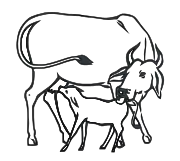Indian National Congress (Requisitionists) | |
|---|---|
 | |
| Abbreviation | INC(R) |
| Founder | Indira Gandhi |
| Founded | 12 November 1969 |
| Split from | INC |
| Succeeded by | INC |
| Ideology | Secularism[1] Nehruvian socialism[2] Economic nationalism[3] Pro-Soviet sentiment[4] |
| Political position | Left-wing[5] |
| Colours | Turquoise |
Indian National Congress (Requisitionists) was created in 1969; it was created and led by Indira Gandhi. Initially this party was known as Congress (R), but it soon came to be generally known as the New Congress or Indicate.
The letter 'R' stands for 'Requisition'.[6] The original congress party then became the Indian National Congress (Organisation), or Congress (O), and was led by Kamaraj. It was informally called the Old Congress or Syndicate and retained the party symbol of a pair of bullocks carrying a yoke. Mrs. Gandhi's breakaway faction were given a new symbol of a cow with suckling calf by the Election Commission as the party election symbol.[6]
The split occurred when, in 1969, a united opposition under the banner of Samyukt Vidhayak Dal won control over several states in the Hindi belt. Indira Gandhi, Prime Minister and daughter of Jawaharlal Nehru, was then challenged by the majority of the party leadership. Gandhi formed the new party to demonstrate her support amongst the people. In the 1971 general election, Congress (R) had secured an overwhelming majority winning 352 out of 518 seats in the Lok Sabha. In the elections to five state assemblies too, the Congress (R) performed well. Later in the 1970s the name Congress (R) evolved to Congress (I) with the 'I' standing for Indira. Gradually, Congress (I) became Indian National Congress, as Congress (O) merged with Janata Party. Other parties split from Congress party were Congress for Democracy, Indian National Congress (Urs) etc.[7]
See also
Notes
- ↑ "Difference between old congress and new congress? | EduRev Humanities/Arts Question".
- ↑ "Difference between old congress and new congress? | EduRev Humanities/Arts Question".
- ↑ "Indira Gandhi nationalised 14 Indian banks on this day: Why she did do that and what was the outcome". Times Now. 19 July 2022.
- ↑ "1971 When Delhi and Moscow came together".
- ↑ "Difference between old congress and new congress? | EduRev Humanities/Arts Question".
- 1 2 Sanghvi, Vijay (2006). The Congress, Indira to Sonia Gandh. New Delhi: Kalpaz Publications. p. 77. ISBN 81-7835-340-7.
- ↑ Andersen, Walter K.. India in 1981: Stronger Political Authority and Social Tension, published in Asian Survey, Vol. 22, No. 2, A Survey of Asia in 1981: Part II (Feb., 1982), pp. 119-135